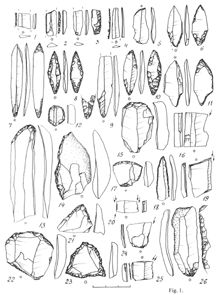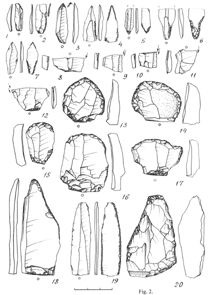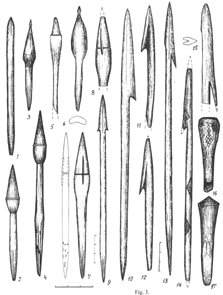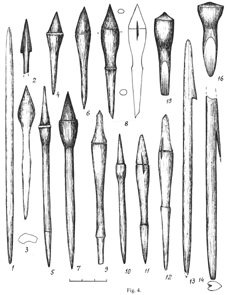 |
Fig. 1. Ozerki 5, stone artefacts of the final period of the Butovo culture from the lower (IV) layer.
|
Translated by the author from: M.G. Zhilin. Nekotoryie problemy perehoda ot mezolita k neolitu na Verhney Volge. In: Problemy izuchenija pervobytnosti i rannego srednevekovja lesnoi zony Vostochnoi Evropy. Ivanovo, 1994, pp. 19-31.
M.G. Zhilin
Some aspectss of the transition from Mesolithic to Neolithic
on Upper Volga.
The Upper Volga culture, singled out by D.A. Krainov, occu-
pies now its proper place in literature, devoted to ealry Neolit-
hic of Eastern Europe. Its chronology, territory, peculiarities
of pottery, lithic and bone inventory are defined in general [1].
But some aspectcs, among them the genesis of the Upper Volga cul-
ture, cause discussion. The opinion of D.A. Krainov and L.V.
Koltsov, that Upper Volga culture is genetically linked with Bu-
tovo mesolithic culture [2], was recently criticised by A.N. So-
roki and A.E. Kravtsov [3]. According to A.N. Sorokin, Butovo
culture ended about 8500 B.P., and hiatus about millenium and a
half can not be filled with any materials now. This author
thinks, that problem of genesis of the Upper Volga culture cannot
be solved now. He considers all published sites of this culture
either too poor, or unrelieable. This characteristic could be
applied to the majority of mesolithic and early neolithic sites,
situated on sandy terraces and dunes. Such situation gives possi-
bilities to some researches to divide homogenous complexes of
early neolithic flints and pottery, dating the former to the Me-
solithic, and attributing pottery to the Neolithic or Bronze age
without sufficient argumentation. Such attempt was made by A.L
Nikitin with site Plesheevo 1 [4], and by A.E. Kravtsov with site
Davydkovo [5], though circumstances of flint and pottery deposi-
tion at these sites show the contrary [6].
Up to the recent time there was almost no data about bone
artefacts of the Butovo culture. Only small part of materials
from sites Ivanovskoye 3 and 7 were published [7], and their lit-
hic inventories are very poor. This led A.N. Sorokin and A.E.
Kravtsov to a conclusion, that cultural attribution of these si-
tes is not clear [8].
Investigations, carried out by the author of the present ar-
ticle in 1989-1992 at the Ozerki (20 km to the south from Tver)
and Dubna (50 km to the north from Sergiev Posad, Moscow region)
peat bogs gave new gomogenous complexes of lithic and bone arti-
facts of late Butovo and early Upper Volga cultures [9]. This gi-
ves possibilities to compare them with each other and with mate-
rials, known from "sandy" sites. Large number of artefacts from
these peat sites make the comparison relieable.
On the other hand, new radiocarbon and pollen datings cor-
rected the chronology of late Butovo culture and of the beginning
of the Neolithic in the Upper Volga - Oka basin. New data for re-
construction of economy of population in the region during late
Mesolithic and early Neolithic were also obtained.
Most part of researchers now links beginning of the Neolit-
hic in the forest zone of Eastern Europe with the introduction of
pottery. This approach is useful for dividing archaeological ma-
terial, though we have no data, indicating any serious economic
changes in early Neolithic, compared with late Mesolithic. Accor-
ding to C-14 datings, pottery appeares in the Upper Volga-Oka ba-
sin about 7000 B.P [10]. Only one dating is related to the end of
the VI millenium B.C. (charcoal from a fireplace at a site Belivo
2 - 7180+-60 B.P.)[11]. Some piece of older wood might had been
burned there, if there was no admixture in the sample or labora-
tory mistake. All the rest datings of sites and layers with early
Upper Volga culture pottery belong to the first quarter of the
Vth millenium B.C. Some new datings appeared recently: the lower
layer of Okayomovo 18 - 6800+-60 B.P., (GIN-6416, from a skull of
a big elk from the concentration of finds at the bottom of the
cultural layer); and the middle layer of Okayomovo 5 - 6800+-140
B.P., (GIN-6193, from a 1-2 cm thick streak of hittia with sherds
of early Upper Volga culture pottery, lieing horosontally). Pol-
len analisys, carried out by E.A. Spiridonova for a number of
stratified sites, shows, that pottery appeares in the region in
early Atlantic. (The author is greatful to E.A. Spiridonova and
L.D. Sulerzhitski for carrying out pollen and C-14 analises).
Several sites of the final and late periods of Butovo cultu-
re were recently dated by C-14 and pollen analises. The most
interesting and abundant in various finds is the IV (lower) layer
of the site Ozerki 5, most characteristic of the final Butovo
culture. The C-14 datings are: 7410+-90 (GIN-6659 - charcoal from
upper part of cultural layer); 7190+-180 (GIN-6660 - charcoal
from lower part of cultural layer); 7120+-50 (GIN-7217 - worked
log from middle part of cultural layer); 6970+-120 - splinters of
worked wood from lower part of cultural layer. The interval
7370-7010 B.P. (the second half - end of the VI millenium B.C.)
can be accepted as the most probable period of habitation of the
site. Pollen analisys shows, that sediments of peat, containing
IV cultural layer, were formed during Boreal/Atlantic transition
and in early Atlantic, which is good support for C-14 datings.
The third cultural layer with pottery of early Upper Volga cultu-
re overlies the IV layer without any sterile streak, and is dated
by pollen to early Atlantic.
The lower layer of the site Okayomovo 4, dated to 7490+-50
B.P.(GIN-6204 - a worked wooden plank from lower part of cultural
layer), and the third cultural layer of the site Nushpoli 11, da-
ted by pollen to early Atlantic, are similar to IV cultural layer
of Ozerki 5. Both sites at the Dubna peat bog. The mesolithic la-
yer of the site Ivanovskoye 3 is dated by C-14 to the second
half - end of the VI millenium B.C [12]. The most part of bone ar-
tefacts is characteristic of final period of Butovo culture. Cul-
tural layers of sites Novoshino [13] and middle layer of Yelin
Bor on Lower Oka are dated to early Atlantic by pollen. The site
Bezvodnoye 10 on Middle Volga, 30 km from confluence of Volga and
Oka, is dated to 6920+-380 B.P. (GIN-5442, charcoal from pit with
flint artefacts).
The lower layer of Okayomovo 5 at Dubna peat bog is dated by
C-14 to 7910+-80 B.P. (GIN-6191 - a thin streak of hittia from
lower part of the train of the cultural layer), and to 7730+-60
B.P. (GIN-6192, hittia from middle part of the train of cultural
layer). By pollen it is dated to Boreal. E.A. Spiridonova suppo-
ses, that C-14 datings have become slightly younger, as a result
of vertical fluctuation of organic in the train. The dating of
this site is about 8000 B.P. Stone artefacts from this layer are
similar to Chernaya 1 in Westerm Meshera (90 km to the east-so-
uth-east from Moscow), which is dated by pollen to late Boreal,
though C-14 datings of charcoal from fireplaces in pits are aro-
und 8500 B.P. So, now we have a series of sites of the Butovo
culture, relieably dated in the interval 8500-7000 B.P., the la-
test of which existed just before introduction of pottery.
Lithic industry of the final period of Butovo culture is
best characterised by the IV (lower) layer of Ozerki 5 (fig. 1).
 |
Fig. 1. Ozerki 5, stone artefacts of the final period of the Butovo culture from the lower (IV) layer.
|
More than 10000 worked flints were found there in 1990-1992,
among them more than 500 finished tools and their fragments. Lo-
cal morraine flint and chert was mainly used as raw material. No-
dules and boulders of it were brought to the site and underwent
all stages of primary and secondary trimming there. Slate, sand-
stone and crystallic rocks were used to a much lesser degree.
Both blades and flakes were produced, the latter served as main
blanks for tools. Among cores amorphous prevail, subconical,
subprismatis and handle cores also met. Substantial part of bla-
des is irregular, regular microblades scarse. Scrapers are most
numerous among stone tools, the number of endscrapers and amorp-
hous scrapers is almost equal; side, round, combined scrapers
compose smaller series. Large side scrapers and microscrapers al-
so present. The number of burins is much smaller, tools on broken
blades and flakes, with one, two or three narrow cutting edges,
dominate. Burins with broad edges, made on broken flakes, or di-
hedral, or combined are scarse.
Insets are mainly bladelets with sharpened or slightly blun-
ted edges, backed bladelets are very rare. Bladelets with retouc-
hed end; oblique and symmetrical points are met. More than 30 ar-
rowheads, most of which are made of blades, were found. Wil-
low-leaf shaped with flat or semi-flat retouch of point and base,
and sometimes, sides prevail. Tanged arrowheads are trimmed in
the same manner. Symmetrical points with similar reotuch are, ob-
viously, fragments or half-finished arrowheads. Secondary trim-
ming of these tools is rather various: together with arrowheads,
worked in traditions of earlier Mesolithic, artefacts with early
neolithic way of secondary trimming are present.
Knives, made of blades and flakes with edges, sharpened by
slanting retouch; concave scrapers, made of flakes; borers and
perforators; and woodcutting tools are numerous. Adzes prevail
over axes, chisels also present. Many of them are polished, espe-
cially those, made of slate and silisized limestone. Chisels with
the end, sharpened by flat retouch on both dorsal and ventral fa-
ce, made of blades, compose a small series. The tool kit is supp-
lemented by combined tools, hammerstones, abrasive slabs,
half-finised tools and fragments.
Main traditions of the previous period are preserved, inno-
vations are traced in diminishing of the role of blades and inc-
rease of the role of flakes as blanks for many tools. The number
and variability of insets and points also desreases; scrapers are
several times more numerous, than burins; tools with narrow wor-
king edge dominate among the latter. Increase of number of arrow-
heads is observed, willow-leaf artefacts are more numerous, than
tanged points; more surface of an arrowhead is retouched, someti-
mes on both dorsal and ventral faces. Number of woodcutting to-
ols, especially polished, and abrasive instruments also increa-
sed, they became more variable.
These features are later observed in lithic inventories of
sites of early period of the Upper Volga culture. The lower layer
of Okayomovo 18 and the third cultural layer of Ozerki 5 gave go-
od amount of various stone artifacts, made, mainly, from local
morraine flint (fig. 2). The role of blades further decreases,
 |
Fig. 2. Okayomovo XVIII, stone artefacts of the early Upper Volga culture from the lower layer.
|
same types of cores are met. Majority of blades are irregular,
but technique of blade production is still on rather high level.
Most part of tools is made of flakes. Scrapers and burins are the
same. Insets are very scarse, represented by bladelets with shar-
pened sides or retouched end.
Willow-leaf shaped and tanged arrowheads compose series, so-
me are made of flakes, oftenly with the whole perimeter, or most
part of it retouched, sometimes from both sides. Rare arrowheads
with whole dorsal face, covered by sloping or semi-abrupt reouch,
with triangular cross-section were met at Ozerki 5, III layer.
Some knives are sharpened with regular wide and long facetted re-
touch. Other tools remain the same, as in final Butovo culture.
Same features are traced in inventories of such "sandy" si-
tes, as Plesheevo 1 and Davydkovskaya, and also in materials of
later sites of Upper Volga culture. At sites of late period of
this culture they are rather obsqure, but still seen. Smooth deve-
lopment of lithic industry is observed, with gradual change of
types and technology of primary and secondary trimming of arte-
facts from late Butovo to Upper Volga culture.
At peat sites of late and final periods of Butovo culture
lithic implements were accompanied by bone and antler artefacts.
Because of availability, standard dimentions and characteristics
of bone and antler of game mammals these tools were less determi-
ned by raw material, than stone tools. Organic materials also gi-
ve better possibilities for making tools of different shape. That
is why, bone and antler tools reflect traditions of their manu-
facturers not less, than lithic tools, but even greater. It is
best seen when dealing with weapons.
Arrowheads are most significant among weapons of late and
final Butovo culture (fig. 3).
 |
Fig. 3. Bone arrowheads of the late and final periods of the Butovo culture: 1,3,6,8,12,14,16,17 - Ozerki 5 (lower layer); 2 - Ivanovskoye 3 (IV layer); 4,7,9,11,13,15 - Okayomovo 5 (lower layer); 5,10 - Okayomovo 4 (lower layer).
|
Various types include: simple needlelike; needlelike with wide
natural groove; with biconical head and resembling biconical;
with willow-leaf shaped head; with
wide flattened head; two-winged with barbs; one-winged with a
barb; two-winged with a barb and similar with a groove for insets
along other side; with massive blunt head. Barbed points are less
numerous and represented by points with sparse barbs and by fi-
ne-toothed points. Straight daggers, some with grooves for insets
along one or both edges; daggers with oblique blade; straight and
curved knives, made of ribs, were found at most sites. Other to-
ols include intact and composite fishing hooks; hide-knives made
of shoulder blades and other bones; rib side-scrapers; awls;
so-called "ice-picks"; antler axes, adzes and chisels; pressure
flakers; punches; numerous burins and burin-side scrapers, made
of beaver' incisors. Ornaments are plenty, made mainly from ani-
mals' teeth, among them leading role belongs to elk and beaver
incisors. Many bone artefacts are ornamented.
Comparison of these artefacts with bone and antler tools of
Upper Volga culture sites (Okayomovo 18, lower layer; Ozerki 5,
third layer; Ivanovskoye 3, third layer; and others) shows more
semblance, than difference. All mentioned types of arrowheads are
known in early Neolithic (fig. 4).
 |
Fig. 4. Bone arrowheads of the Upper Volga culture: 1-7,9-13, 16 - Okayomovo 18 (lower layer); 8 - Ozerki 5 (III layer);14-15 - Ivanovskoye 3 (III layer).
|
Modification of previously
known types leads to emergence of figured arrowheads (fig. 4,
8,9,11,12), widespread in Upper Volga culture. Arrowheds with bi-
conical head become shorter, the head is usually irregular, espe-
cially at later sites. Short shallow grooves in the widest part
of arrowheads (fig. 3, 7,8; 4, 8,11,12) are very characteristic
of final Butovo and Upper Volga culture, but not of other cultu-
res at that time. Barbed points, harpoons, daggers, many objects
of everyday life and ornaments from Upper Volga culture sites are
the same, as from sites of the final period of the Butovo cultu-
re. Ornamentation on these artefacts is also similar in two cul-
tures.
Another important link between them is a series of pebbles
with engraved geometric designs, similar to Australian "churin-
gas". Their fragments were found in the mesolithic (IV) layer of
Ozerki 5 and several sites of Upper Volga culture. In both cases
these pebbles were broken by a very strong blow, oftenly, at the
engraving, and after it burnt.
Thus, formation of the Upper Volga culture on the basis of
Butovo culture is clear now. It is proved by stratigraphy of peat
sites, pollen and C-14 chronology, semblance of lithic, bone and
antler artefacts, specific features of art and spiritual culture,
characterising the former and the latter. Process of neolithisa-
tion of inventory of Butovo culture, clearly observed in its fi-
nal period, ends with introduction of pottery.
Artefacts, faunal and floral remains from peat sites of Up-
per Volga region give good data for studies of economy of late
Butovo and early Upper Volga cultures. It was based on hunting,
main objects, in the Mesolithic, as well, as in early Neolithic,
were elk and beaver. Other forest animals were also hunted, but
their significance was much lesser. Role of fowling was gradually
increasing. Fishing was also important at this time. Species are
various, but pike dominates. Food-gathering was practised in warm
seasons by population of Butovo and Upper Volga culture. Hazelnut
and waternut shells, seeds of yellow water lilies were met, the
latter in human excrements together with bones of small fish.
Such complex hunting-fishing-gathering economy succesfully deve-
loped for a millenium or more after introduction of pottery on
Upper Volga. There are no indications of any elements of produc-
tive economy in early and middle Neolithic of the region. No
signs of crisis of complex hunting-fishing-gathering economy du-
ring transition from the Mesolithic to Neolithic on Upper Volga
can be seen. All data show successful adaptation of population of
Butovo and Upper Volga cultures to gradual changes of environment
in the first half of Holocene.
References
1. Krainov D.A., Hotinsky N.A. Verhnevolzhskaya ranneneoli-
ticheskaya kultura. In: Sovetskaya Arheologiya, 1977:3. Kraynov
D.A., Hotinsky N.A. Hronologiya, periodizatsiya i paleogeografiya
pervobytnyh plemen Centra Russkoi ravniny v holocene. In: Arheo-
logiya i paleogegrafiya mezolita i neolita Russkoi ravniny. Mosk-
va, 1984.
2. Krainov D.A., Koltsov L.V. 25 let Verhnevolzhskoy ekspe-
dicii. In: Sovetskaya arheologiya, 1983:4.
3. Sorokin A.N. Butovskaya mezoliticheskaya kultura. Po ma-
terialam Desninskoy ekspedicii.
Moskva, 1990. Kravtsov A.E., So-rokin A.N.
Aktualniye voprosy Volgo-Okskogo mesolita.ÿ. Moskva,1991.
4. Nikitin A.L. Stoyanka Plesheevo 1. In: Sovetskaya Arheo-
logiaÿ., 1978:4.
5. Kravtsov A.E. K hronologii butovskoy i ienevskoy mezoli-
ticheskih kultur. In: Sovetskaya Arheologiya, 1991:2.
6. Sidorov V.V. Davydkovskaya stoyanka na reke Yahrome. In:
Sovetskaya Arheologiyaÿ., 1973:2. Zhilin M.G. O datirovke i kultur-
noy prinadlezhnosti stoyanki Plesheevo 1. In: Sovetskaya Arheolo-
giyaÿ., 1982:3.
7. Kraynov D.A., Hotinsky N.A. Ivanovskiye stoyanki - komp-
lex mezo- i neoliticheskih ozerno-bolotnyh poseleniy v Volgo-Oks-
kom mezhdurechye. In: Arheologiya i paleogegrafiya mesolita i ne-
olita Russkoi ravniny. Moskva, 1984.
8. Kravtsov A.E., Sorokin A.N. Aktualniye voprosy...
9. Zhilin M.G. Arheologicheskiye issledovaniya v basseine r.
Dubny v 1987-1990 gg. In: Pamayatniki istorii i kultury Verhnego
Povolzhya. Nizhniy Novgorod, 1991.
10. Zhilin M.G. Ranneneoliticheskaya stoyanka Utreh 2. In:
Arheologicheskiye pamyatniki Volgo-Klyazminskogo mezhdurechya.
Ivanovo, 1990:3.
11. Kravtsov A.E. O hronologii mezoliticheskih i ranneneoli-
ticheskih pamyatnikov Mescherskoy nizmennosty. In: Voprosy arheo-
logii i istorii Verhnego Poochya. Kaluga, 1987.
12. Krainov D.A., Zaitseva G.I., Utkin A.V. Stratigrafiya i
absolutnaya hronologiya stoyanki Ivanovskoye 3. In: Sovetskaya
Arheologiya, 1990:3.
13. Zhilin M.G. Mezoliticheskaya stoyanka Novoshino na Nizh-
ney Oke. In: Arheologiya Verhnego Povolzhya. Nizhniy Novgorod,
1991.